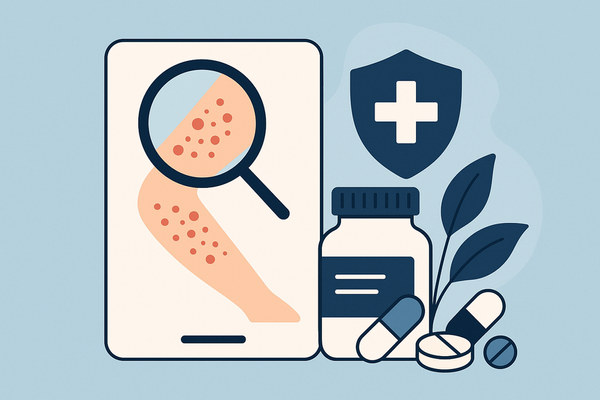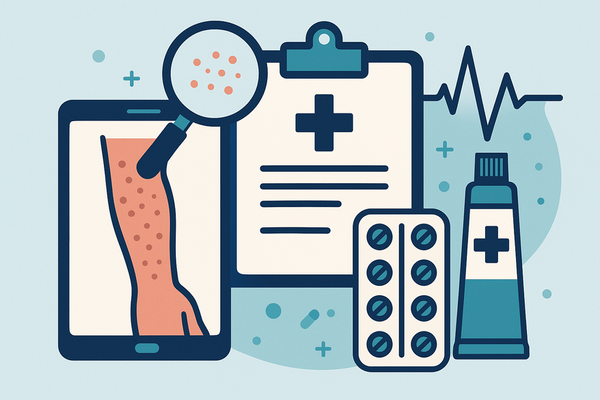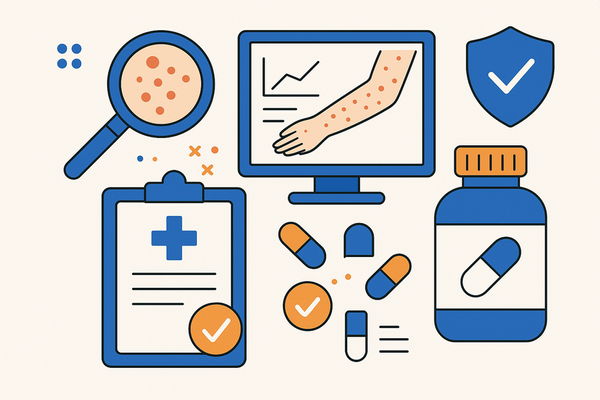Traditional Rash Diagnosis vs AI: A Comprehensive Comparative Guide
Explore the pros and cons of traditional rash diagnosis vs AI in accuracy, speed, and patient care. Discover how a hybrid model can offer optimal outcomes.
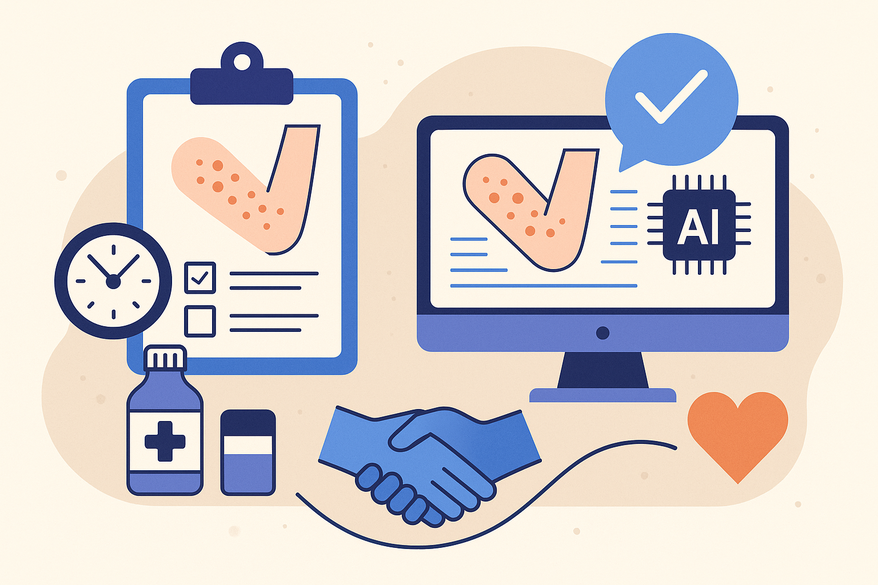
Estimated reading time: 8 minutes
Key Takeaways
- Traditional diagnosis relies on clinician expertise with 80–85% accuracy but suffers delays and variability.
- AI-based methods achieve over 90% accuracy, offer rapid analysis, and improve access, yet face bias and integration challenges.
- Comparison highlights trade-offs in speed, cost, and patient experience.
- Hybrid approach—AI pre-screens and experts review—promises optimal outcomes.
Table of Contents
- What Is Traditional Rash Diagnosis?
- How AI Is Revolutionizing Rash Diagnosis
- Traditional vs AI: Side-by-Side Comparison
- Case Studies: AI vs Traditional Outcomes
- The Future of Rash Diagnosis
- Conclusion: Weighing Traditional Care Against AI Innovation
- Next Steps & Further Reading
- FAQ
Section 1: What Is Traditional Rash Diagnosis?
Clinical evaluation begins with a detailed history and visual inspection. Three core steps define the traditional approach:
- Medical examination
- Detailed history taking: onset, progression, triggers, and context.
- Visual inspection: color, shape, size, and texture under optimal lighting.
- Laboratory tests
- Skin biopsy: microscopic analysis for conditions like psoriasis or eczema.
- Bacterial/fungal cultures: rule out infectious causes.
- Blood tests: detect autoimmune markers or allergic responses.
- Dermatologist expertise
- Pattern recognition: years of practice build a mental library of rash presentations.
- Clinical reasoning: integrates visual cues with patient history for holistic assessment.
Historical effectiveness: Skilled dermatologists often reach diagnostic accuracy rates of 80–85%. Their nuanced judgment catches atypical cases beyond textbook patterns.
Limitations:
- Variability in expertise can lead to diagnostic errors and inter-observer disagreement. Source: PMC study
- Delays due to wait times for specialist appointments and lab results.
- Subjectivity influenced by clinician fatigue or bias.
Section 2: How AI Is Revolutionizing Rash Diagnosis
AI methods are transforming rash detection by leveraging image analysis and pattern recognition:
- Machine learning vs deep learning
- Machine learning: trains on labeled datasets to predict rash categories.
- Deep learning (e.g., convolutional neural networks): automatically learns image features through multiple layers.
- Imaging analysis
- High-resolution smartphone or dermatoscope inputs.
- Preprocessing: color normalization, segmentation, noise reduction.
- Feature extraction: CNNs identify border irregularity and pigment variation.
- Pattern recognition
- Algorithms classify images into diagnostic categories (e.g., eczema vs fungal rash) using probabilistic models.
Accuracy metrics:
- ResNet and EfficientNet models achieve up to 91.2% accuracy in multimodal tasks. Source: arXiv paper
- Over 90% precision and F1 scores in melanoma vs benign lesion classification. Source: melanoma study
Current benefits:
- Instant analysis in under a minute per case, boosting teledermatology throughput. Source: arXiv paper
- Extended access for remote and underserved populations via smartphone tools.
Challenges:
- Dataset bias: underperformance on darker skin without diverse training data. Source: melanoma study
- Generalizability: variations in device and lighting demand robust preprocessing.
- Integration: embedding AI outputs into electronic health records and workflows.
- Validation: continuous monitoring and retraining to ensure safety.
For a deeper dive into AI dermatological techniques, see how AI diagnoses rashes and explore machine-learning skin analysis.
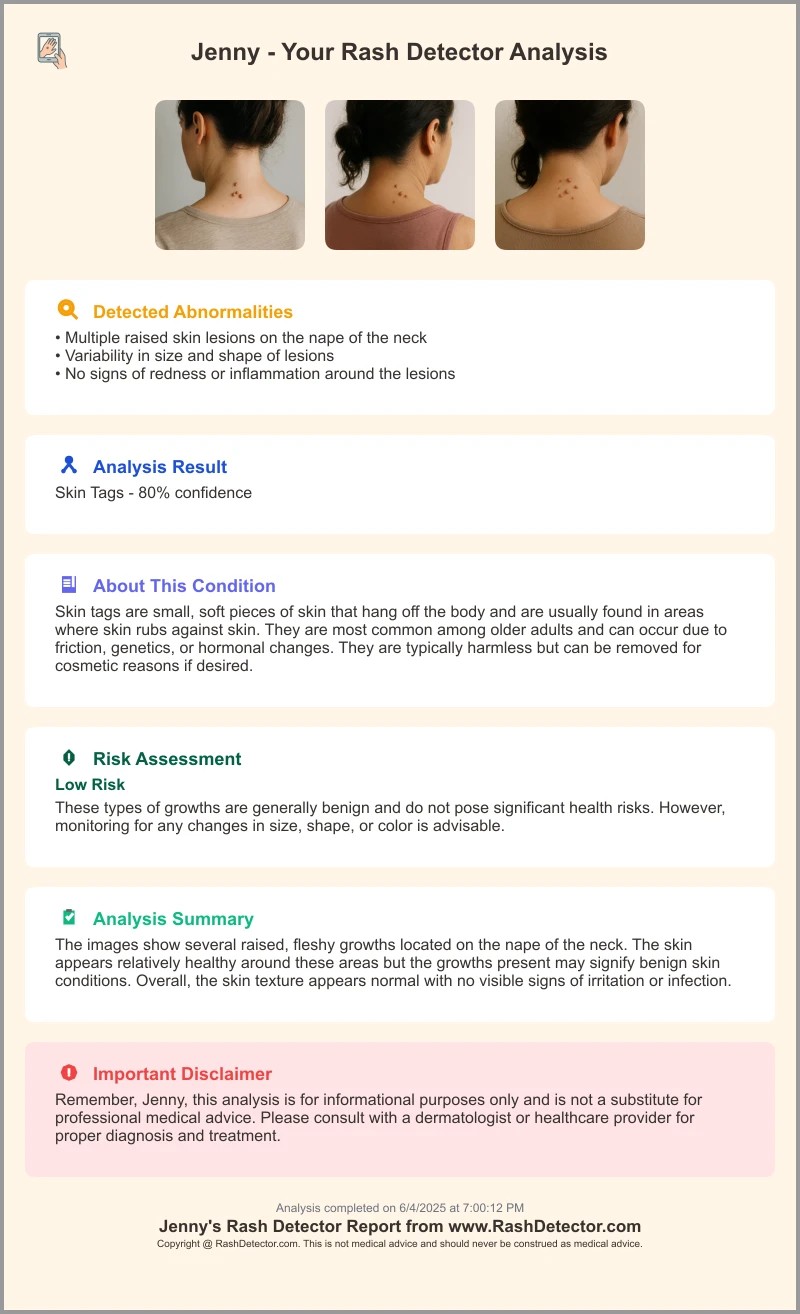
AI delivers high throughput and reproducibility but must address bias, privacy, and integration to earn clinical trust.
Section 3: Traditional Rash Diagnosis vs AI: Side-by-Side Comparison
| Metric | Traditional | AI |
|---|---|---|
| Accuracy | 80–85%, clinician-dependent | Often >90%, top models hit 91.2% |
| Speed | Hours to days | <1 minute per case |
| Cost & Access | Limited dermatologist availability, higher fees | Smartphone-enabled, lower marginal cost |
| Experience | Personal rapport, holistic context | Rapid feedback, lacks empathetic interaction |
| Expertise vs Computation | Complex reasoning, rare case detection | Consistent pattern recognition, may miss non-visual clues |
For technical details, refer to technical process in AI-driven rash detection.
Section 4: Case Studies: AI vs Traditional Outcomes
Study 1 – Melanoma vs Benign Lesions
AI achieved 92% accuracy and precision in differentiating malignant from benign skin lesions, matching expert dermatologists. Source: melanoma study
Study 2 – Multimodal Diagnostic AI
A deep learning system combining images and symptom data recorded 91.2% diagnostic accuracy across common rashes. Source: arXiv paper
Study 3 – Clinical Workflow Integration
A hospital trial showed AI decision-support delivered results in ~1 minute per case, reduced errors, and streamlined dermatologist review. Source: PMC study
Section 5: The Future of Rash Diagnosis: Integrating AI & Expert Care
Advancements in AI:
Federated learning protects privacy while enabling diverse training data.
Integration with medical knowledge graphs for real-time literature referencing. Source: arXiv paper
Hybrid Models:
AI pre-screens and flags high-risk cases for dermatologist review, allowing clinicians to focus on complex cases.
Patient Empowerment:
Smartphone apps prompt earlier care-seeking. Teledermatology platforms connect patients to virtual consults with AI triage.
Regulatory Evolution:
Future guidelines will demand AI transparency, performance logging, and privacy safeguards, plus standardized model metric reporting for safety.
Section 6: Conclusion: Weighing Traditional Care Against AI Innovation
Traditional methods offer nuanced, contextual assessments but face variability and delays. AI innovations deliver rapid, reproducible analysis and broader access but require validation and may lack empathy. A balanced, hybrid solution—where AI assists and dermatologists make final decisions—appears to be the most promising path to safe, effective skin-care workflows.
Section 7: Next Steps & Further Reading
Next Steps:
If you have a skin concern, consult a licensed dermatologist or qualified healthcare professional.
Consider AI tools as decision-support, not replacements for medical advice.
Discuss how teledermatology and AI can fit into your care plan.
Further Reading:
• Traditional method limitations: PMC study
• AI in dermatology protocols: AI dermatology protocol
• Latest AI model study: arXiv paper
FAQ
1. Is AI dermatology reliable enough for self-diagnosis?
AI tools can provide preliminary assessments with high accuracy but should not replace professional evaluation.
2. How do I choose between traditional consultation and AI apps?
Use AI for quick screening and initial guidance, then seek a dermatologist for complex or persistent issues.
3. Can AI handle rare or atypical rashes?
AI excels with common patterns but may struggle with rare presentations; clinician expertise remains essential.
4. What are the privacy concerns with AI skin analysis?
Ensure any app complies with data protection regulations and uses secure transmission and storage.
5. How will regulation shape AI in dermatology?
Future guidelines will require performance logging, transparency, and standardized reporting to ensure patient safety.


